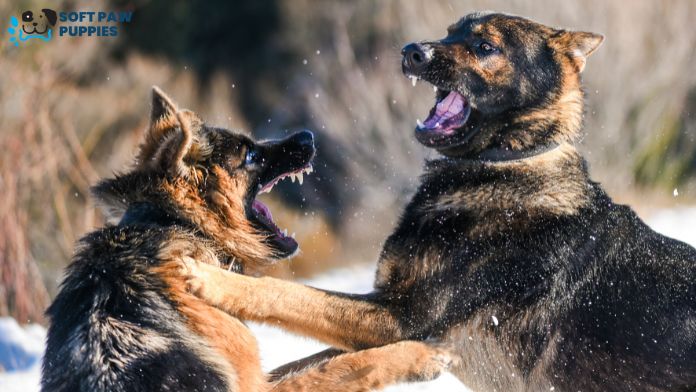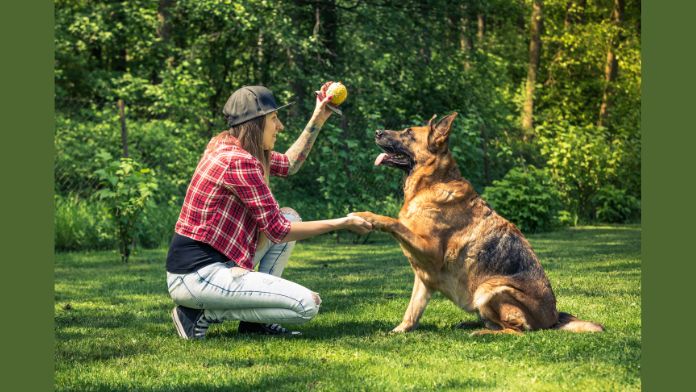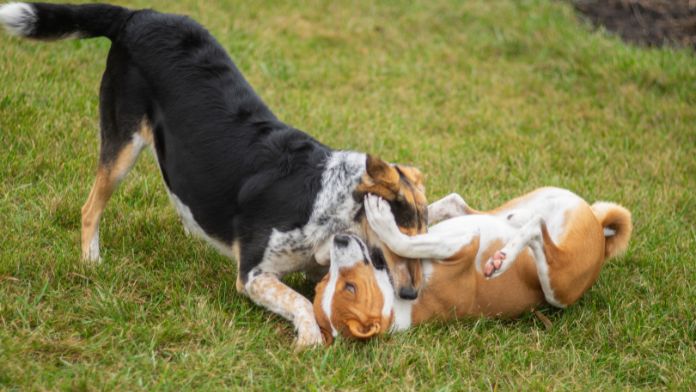
When it comes to the behavior of our furry companions, there is often a lot of curiosity and concern, especially when it comes to interactions between male and female dogs. One common question pet owners may have is, Will a male dog attack a female dog? To address this question and shed light on the complexities of canine behavior, we’ll delve into dog dynamics, socialization, and aggression in this article.
Understanding Canine Behavior
Before we can explore the dynamics of male and female dog interactions, it’s crucial to have a basic understanding of canine behavior. Dogs, like humans, have individual personalities and temperaments. Various factors, including genetics, early life experiences, socialization, and training, can influence their behavior.

Dogs are social animals that thrive on relationships and hierarchies. They communicate primarily through body language, vocalizations, and scent. While aggression is a part of the canine repertoire, it’s not the default behavior for most dogs. Dogs avoid confrontation and often use subtle cues to resolve conflicts before escalating into aggression.
Do Male Dogs Attack Female Dogs?
Dog behavior, including aggression is influenced by various factors such as genetics, socialization, training, and individual temperament. It is inaccurate to generalize that male dogs will inherently attack female dogs. Instead, aggression in dogs is often related to specific circumstances and can occur between dogs of any gender.
Aggression in dogs may be territorial, fear-based, possessive, or a result of improper socialization. Intact male dogs (those that have not been neutered) may exhibit more assertive behaviors, including aggression, especially in the presence of a female in heat. Neutering can sometimes help reduce aggressive tendencies, but it is not a guaranteed solution.
Why Do My Male And Female Dogs Fight?

Male and Female Dogs May Fight For Several Reasons:
Territorial Disputes: Dogs can become territorial and may fight to establish dominance over certain spaces or resources, like food or toys.
Reproductive Aggression: Unneutered males may become aggressive when they sense a female in heat, which triggers their mating instincts.
Resource Guarding: Dogs might fight over valuable resources like food, treats, or attention.
Lack of Socialization: If your dogs were properly socialized as puppies, they may need to learn how to interact appropriately with each other.
Fear or Anxiety: Fearful or anxious dogs may react aggressively when threatened.
Male-Female Dog Interactions
Several factors come into play regarding interactions between male and female dogs. Here are some key considerations:
- Socialization: Proper socialization during a dog’s formative weeks and months shapes its behavior. Dogs exposed to various other dogs, including males and females, are more likely to be well-adjusted and less prone to aggression.
- Individual Temperament: A dog’s temperament plays a significant role in its interactions with other dogs. Some dogs are naturally more dominant or assertive, while others are more submissive. These traits can be independent of gender.
- Neutering/Spaying: A dog’s reproductive status can affect its behavior. Intact (unspayed or unneutered) dogs may be more prone to aggression, especially in the presence of a female in heat. Neutering and spaying can help reduce these tendencies.
- Environmental Factors: The environment in which dogs interact can also influence their behavior. For example, resource guarding, such as food or toys, can lead to conflicts between dogs of any gender.
- Training and Socialization: Proper training and ongoing socialization can significantly impact how a dog interacts with others. Well-trained dogs are more likely to respond to commands and exhibit appropriate behavior in various situations.
Are Female Dogs More Aggressive Than Male Dogs?
Whether female dogs are more aggressive than male dogs often sparks debate among dog owners and experts. It’s important to note that generalizations about canine behavior based solely on gender may oversimplify the complex nature of individual dogs.
In many cases, aggression in dogs is influenced by genetic factors, early socialization experiences, training, and the dog’s overall environment. While some believe male dogs may exhibit more dominant or territorial behavior and female dogs may display protective or maternal instincts, these tendencies are not universal.
Several factors contribute to a dog’s temperament, including breed, genetics, and personality. For instance, certain breeds may have predispositions toward assertiveness or protectiveness, but this doesn’t necessarily correlate with gender. Additionally, the dog’s upbringing, socialization, and training play crucial roles in shaping its behavior.
Hormones can also influence behavioral differences between male and female dogs. Intact male dogs may exhibit more territorial or dominant behaviors, especially if they sense a potential mate nearby. Female dogs, on the other hand, might display protective instincts during their heat cycles.
Why Is My Male Dog Attacking My Female Dog?
The short answer to whether a male dog will attack a female dog is that it depends on various factors. Most male dogs do not have a natural predisposition to attack female dogs. However, specific situations or conditions can increase the likelihood of conflicts or aggression:
- Resource Guarding: Dogs may become aggressive when they feel that their resources, such as food, water, or toys, are threatened. This behavior can occur between dogs of any gender.
- Territorial Behavior: Dogs are territorial animals who may become protective of their territory, including their home or yard. This protective behavior can lead to conflicts with other dogs.
- Reproductive Aggression: Unneutered male dogs may display heightened aggression when encountering a female in heat. This is a natural response driven by their reproductive instincts.
- Fear or Anxiety: Fearful or anxious dogs may react aggressively in certain situations as a defense mechanism. This behavior is not limited to interactions between male and female dogs.
- Lack of Socialization: Dogs that have not been properly socialized may struggle to interact with other dogs, regardless of gender, and may exhibit fear-based aggression.
Which Dog Gender Is More Aggressive?
Aggression in dogs is not determined solely by gender. Both male and female dogs can display aggression, but the reasons behind it and its form may vary. Unneutered males might display more aggression related to mating instincts, such as an older dog attacking a new puppy. At the same time, females may exhibit aggression in response to perceived threats to their pups. Individual temperament and experiences play significant roles in aggression, making it hard to generalize.
Preventing Aggression In Male-Female Dog Interactions
To reduce the risk of aggression between male and female dogs, consider the following tips:
- Spaying and Neutering: If you do not plan to breed your dog, consider spaying or neutering them. This can reduce the likelihood of aggressive behavior related to mating instincts.
- Socialization: Early and ongoing socialization with other dogs of various genders and sizes is essential to help your dog develop good social skills and behavior.
- Training: Enroll your dog in obedience training classes to ensure they respond to commands and can be controlled in various situations.
- Supervision: Always supervise interactions between male and female dogs, especially if they are unfamiliar with each other. This is particularly important when introducing a new dog to your household.
- Manage Resources: Prevent resource guarding by teaching your dog to share resources and avoid situations where they might need to protect their belongings.
Are Female Dogs Less Aggressive Than Males?
There needs to be a definitive answer to this question. The level of aggression in dogs varies greatly among individuals and can be influenced by genetics, socialization, training, and experiences. Some female dogs may be less aggressive than males, while others may display more aggression, especially if protecting their offspring.
It’s important to remember that aggression is a complex behavior, and any generalization about gender differences should be taken cautiously. Do female dogs attack male dogs? The key is understanding and addressing the specific causes of aggression in your dogs and seeking professional help to ensure a safe and peaceful environment for your furry companions.
Conclusion
A male dog will not attack a female dog without specific triggers or underlying issues. Canine behavior is complex and influenced by numerous factors, including socialization, training, temperament, and environmental conditions. Responsible pet ownership, including proper training, socialization, and spaying/neutering, can go a long way in preventing aggression and promoting positive interactions between male and female dogs. Understanding your dog’s needs and behaviors is the key to fostering a harmonious relationship between them and their canine companions of any gender.
FAQ
Male Dogs Ever Bite Female Dogs?
Male dogs usually do not attack female dogs unless they try to defend themselves. A male dog may turn hostile toward another pet when defending itself or its belongings, especially if the other pet is a female. However, male dogs nearly always engage in combat with other male dogs.
Why Do Male Dogs Battle One Another?
Competition is yet another factor in why male canines fight other male dogs. Perhaps another dog is nearby, or the male and female dogs are playing in the backyard. These dogs may feel vying for territory, resources, or attention, which might turn violent.
Do Female Dogs Ferociously Protect Their Young?
When a female dog has just given birth, she will vigorously protect her puppies from potential threats. Since a dog mother will do anything to protect her offspring, this use of force is fully unfettered.
Are Dogs Hostile When They’re Hurt?
When hurt, a normally friendly and gentle dog may become violent. Females will continue to fight for access to males, and intact male canines will continue to battle for the attention of females in heat. Some companion dogs engage in traditional canine predatory actions like chasing and snatching at moving objects.






